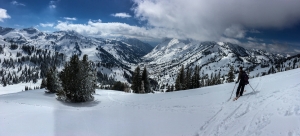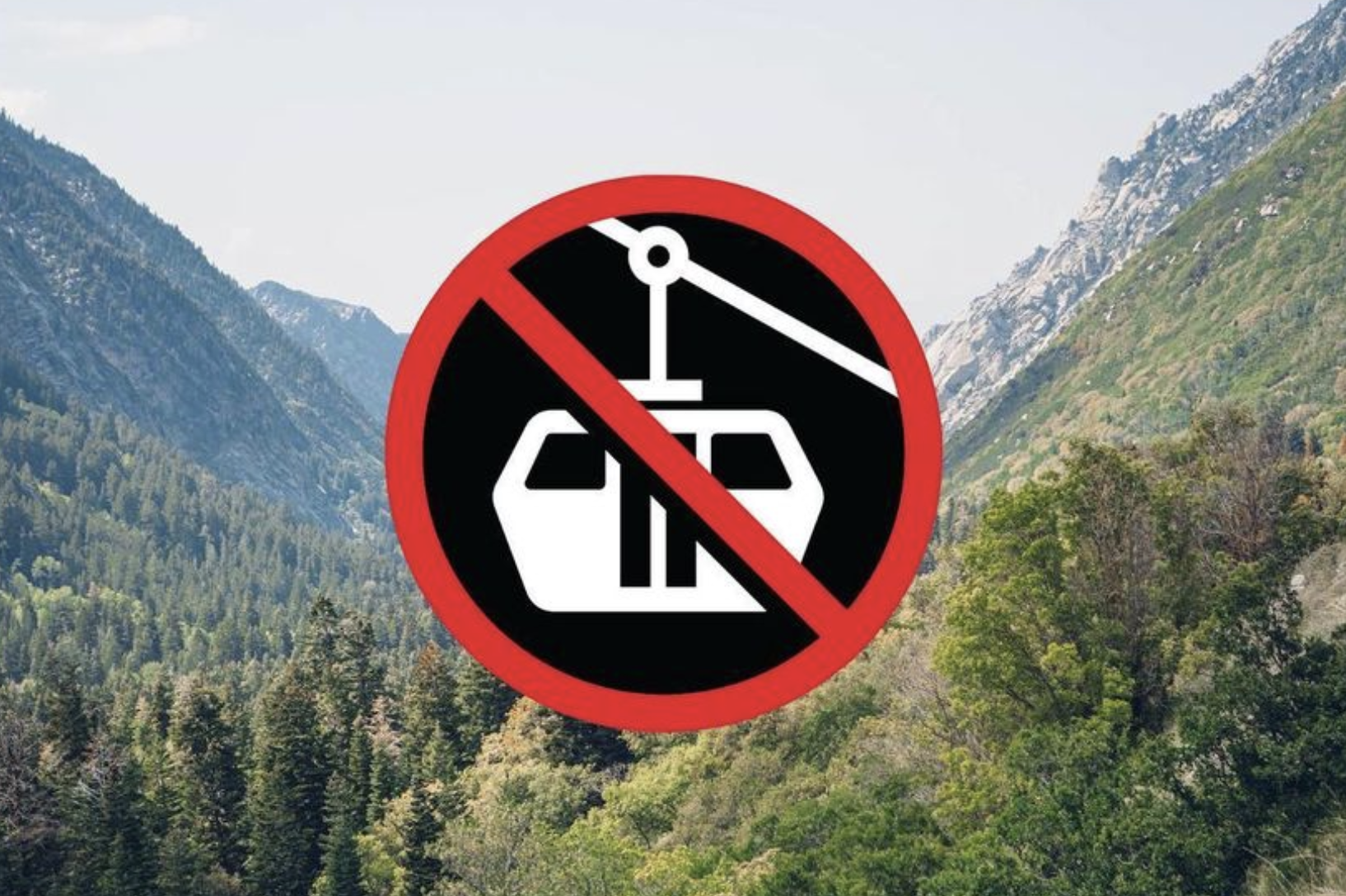
Holiday Ideas as a New Decade Begins
Wasatch Environmental Update for Decemeber 29, 2019
By John Worlock
Holiday Ideas as a New Decade Begins
Happy Holidays!
We’d like to make a couple of suggestions for how to use your holiday-time as a new decade begins.
First of all, renew your love affair with the Wasatch Mountains. They are your friends. They are your benefactors. Let us count the ways:
They are beautiful, providing a spectacular backdrop for our valley-based lives. They are even more beautiful up close and we can see this in person with just a short trip one of many canyons to reach a trail into the wilderness.
They are quiet and tranquil, allowing us to listen for the calls of birds, the gurgle of the snowmelt flowing in the streams, and the sound of the wind in the branches of the trees.
They are filled with the wonders of nature: abundant wildflowers and fall foliage, each in their season, along with hoofedand clawedand furriedand finnedwild things who are free to roam their unspoiled habitat.
Their snowmelt provides clean drinking water for many valley residents.
They are the providers of space and terrain for an immense variety of year-round outdoor recreation, and surely you have your own favorite mountain activities.
OK, now that you’ve renewed your love affair with the Wasatch Mountains, we want you to take a few minutes to become acquainted with the activities of Save Our Canyons.
Why? Because Save Our Canyons is devoted to preserving those attributes of the Wasatch Mountains that we have just mentioned, the attributes that elevate our lives above the mundane and the quotidian. Our mission statement declares simply that we are (quote) “dedicated to protecting the wildness and the beauty of the Wasatch Mountains, canyons and foothills.’
Please, then, take a few minutes to learn about current campaigns and activities at Save Our Canyons. For much of our work, we count on citizen participation, pushing for beneficial actions by the legislature or one or more county or municipal councils. We also need volunteers, as in our ambitious year-long survey of non-motorized recreation in the Central Wasatch.
Read about our campaigns and our dreams for the coming year - at save our canyons dot org.
Thanks for listening, and Happy New Year!
Above and Beyond the Wasatch
By John Worlock
“Above and Beyond the Wasatch”
For close to half a century, our organization, Save Our Canyons has focused its attention to the Wasatch Range, and more specifically, the Central Wasatch, and even more specifically, the special canyons that have given citizens of Salt Lake City and the Salt Lake Valley the immediate access to mountain recreation and solitude.
We speak, of course of the Big and Little Cottonwood Canyons and the Mill Creek Canyon. Those are the canyons we have, according to our name, been trying to save.
We’re still trying, and much of our attention today is focused on the proposed federal legislation called the Central Wasatch National Conservation and Recreation Act. It is the natural offspring of the multi-year and multi-partner project called the Mountain Accord, intended to arrest the piece-meal commercial development of those beautiful canyons, leaving them wild and welcoming to those seeking the restoration of spirit that they offer.
Please go to the website of the Central Wasatch Commission to learn more about that important legislation. While you’re at it, go to saveourcanyons dot org and see what Save Our Canyons would like you to do to ensure its congressional success.
But now, let’s take a wider view and ask what is the origin of the threats to our natural environment. It doesn’t take a wizard to see that our opponent is the widely accepted ambition forGrowth. Our ski resorts claim to need more space and infrastructure in response to what they see as Pressureto accommodate the growing numbers of people seeking the Best Snow on Earth. Nearby, the Great Salt Lake is threatened by a plan to divert its benevolent Bear River to support the presumably desirable Growth of housing and business in the Salt Lake Valley.
Regulators and planners have no answer to this commercial drive for more houses, more businesses, more traffic, as exemplified by the proposal to use tax incentives to grow the Utah Inland Port.
We are horrified to think what our lives will be in thirty years when the population of the Wasatch Front has, according to predictions, doubled. It is time to find the brake-lever and suppress the dangerous need for Growth.
Save Our Canyons Summary And Fact Sheet of UDOT’s LCC EIS
This summary and fact sheet should help Save Our Canyons members understand and craft their comments to Utah Department Of Transportation’s (UDOT) Little Cottonwood Canyon (LCC) Environmental Impact Statement (EIS).
As a reminder you can submit comments here until June 14th!!!
What Is The Purpose Of This Project?
UDOT’s stated purpose for the LCC EIS is “to substantially enhance safety and improve mobility with respect to managing avalanche risk; improve operations at key intersections and parking at trailheads in Little Cottonwood Canyon; and improve the mobility on Wasatch Boulevard for residents, visitors, and commuters who use S.R. 210.”
The idea is “through transportation improvements, UDOT intends to mitigate congestion on S.R. 210 and improve recreation and tourism experiences for all users of the canyon. In providing these improvements, UDOT will consider the character, natural resources, watershed, diverse uses, and scale of Little Cottonwood Canyon.”
UDOT’s stated goals for the “North Little Cottonwood Road and Little Cotton Canyon Road” segments are to:
- Improve the road’s reliability by substantially reducing the number of days and hours that the road is closed for avalanche mitigation and incidents.
- Improve safety by reducing the risk of avalanches to roadway users.
- Enhance roadway safety at trailhead parking areas for pedestrians and bicyclists and decrease conflicts between motorized and nonmotorized transportation modes.
- Prevent roadside pavement damage caused by on-road parking at trailheads.
In addition to these goals, UDOT recognizes the importance of Little Cottonwood Canyon to Salt Lake City’s water supply and is committed to maintaining “the integrity of the watershed.”
What Is The Need For The Project?
UDOT articulates five reasons why this project is needed:
- The avalanche hazard poses a risk to winter travelers in Little Cottonwood Canyon. The current avalanche-control program requires periodic road closures that can cause 2-to 4-hour travel delays, which can cause traffic to back up in the neighborhoods at the entrance of the canyon.
- There are roadway elements that do not meet current design standards; for example, shoulders that are too narrow, and horizontal and vertical curves that are too steep and/or sharp.
- Vehicles parked on the shoulder force cyclists and pedestrians into the roadway travel lane, which is a safety concern. The on-road parking also damages the pavement edge, thereby increasing soil erosion into nearby streams.
- There are limited parking and restroom facilities at trailheads to support recreation in the canyon.
- Commuter traffic on Wasatch Boulevard results in congestion on weekdays.
Other Points Of Interest/Consideration
- With the projected levels of population increase in both Salt Lake and Utah County’s –– 36% and 108% respectively –– much of UDOT’s proposals seems to revolve around solving congestion issues in the Canyons as this affects both commuter traffic along Wasatch Boulevard and tourist traffic in Little Cottonwood Canyon. As the report states, “any issues in the canyon can have major impacts on the mobility to get from the canyon to connecting roads.”
- The LCC EIS repeatedly mentions Senate Bill 277, which passed the State of Utah legislature in 2017. As the EIS states, this bill is meant to provide funding “for transportation improvement projects that ‘have a significant economic development impact associated with recreation and tourism within the state’ and that ‘address significant needs to congestion mitigation.’” As well, the EIS mentions how despite a lack of quantitative data, ski industry experts surmise that the current congestions issues in the Canyons have “substantial effects on skier days and potential revenue.”
- Interestingly, UDOT reports that 78% of skiers arrive at the Canyon resorts by private or rental vehicle. However, the EIS also mentions that during the winter of 2016/2017 when UTA revised the bus service in the Canyons and increased the frequency of trips, they saw a 26% increase in ridership. The report also mentions the lack of reliable summer bus service in the Canyons currently and the parking (and safety) issues this creates.
- UDOT states that the Avalanche Hazard Index (AHI) for Little Cottonwood Canyon is exceptionally high “because increased vehicle use results in a higher risk.” The report also mentions how the design of SR-210 is challenging for drivers, which results in crashes that affect traffic and congestion. Furthermore, the EIS acknowledges that parking capacity in the Canyons, as mandated by the current Forest Plan, cannot be modified except for watershed protection or to facilitate mass transit.
Given this information, we encourage UDOT to find a solution that improves visitor safety and supports a healthy watershed, air quality, and user experience.



